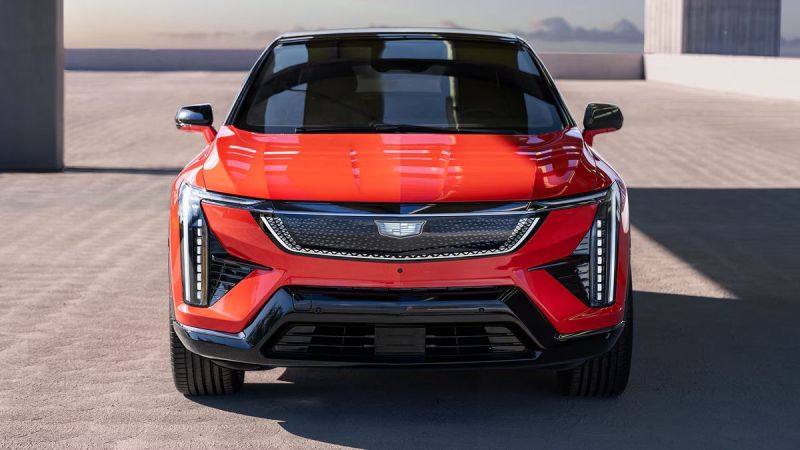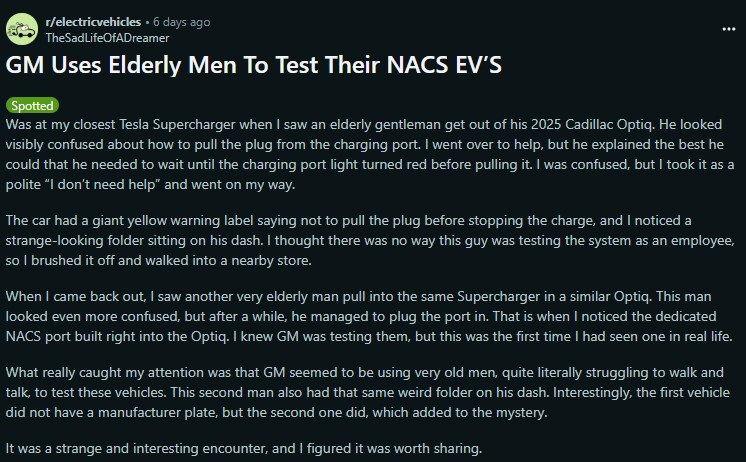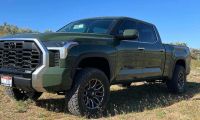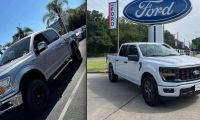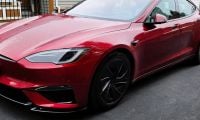Somewhere between Ultium battery packs and in-dash TikTok apps, we’ve reached a point where automakers are stealth-testing their EV interfaces using senior citizens. Yes, you read that right.
And no, this isn't satire from The Onion or a fever dream from Cyberpunk 2077. It’s real. It’s happening. And the source? A post on the r/electricvehicles subreddit by a user with the name, TheSadLifeOfADreamer.
“Was at my closest Tesla Supercharger when I saw an elderly gentleman get out of his 2025 Cadillac Optiq. He looked visibly confused about how to pull the plug from the charging port. I went over to help, but he explained the best he could that he needed to wait until the charging port light turned red before pulling it. I was confused, but I took it as a polite ‘I don’t need help’ and went on my way.
The car had a giant yellow warning label saying not to pull the plug before stopping the charge, and I noticed a strange-looking folder sitting on his dashboard. I thought there was no way this guy was testing the system as an employee, so I brushed it off and walked into a nearby store.
When I came back out, I saw another very elderly man pull into the same Supercharger in a similar Optiq. This man looked even more confused, but after a while, he managed to plug the port in. That is when I noticed the dedicated NACS port built right into the Optiq. I knew GM was testing them, but this was the first time I had seen one in real life.
What really caught my attention was that GM seemed to be using very old men, quite literally struggling to walk and talk, to test these vehicles. This second man also had that same weird folder on his dashboard. Interestingly, the first vehicle did not have a manufacturer plate, but the second one did, which added to the mystery.
It was a strange and interesting encounter, and I figured it was worth sharing.”
Now, to the uninitiated, this might seem like just another oddball post on Reddit.
But if you’ve spent any time watching how the American auto industry operates behind the curtain, you’ll recognize this for what it is, a revealing, unscripted peek at how the sausage gets made.
No camouflage wraps, no security detail, no embargoed press kits, just a couple of bewildered senior citizens, standing in the crosshairs of EV adoption with a 2025 Cadillac Optiq and a laminated folder.
Senior Drivers Test Tesla Superchargers in Cadillac Optiqs
What’s brilliant, either by design or sheer accident, is that these senior testers are perfect for the job. One commenter nailed it,
“There are a lot of older folks who will need to learn how to charge EVs in the future, and data is king.”
The average new car buyer is 53, not some Gen Z coder livestreaming his road trip to Coachella.
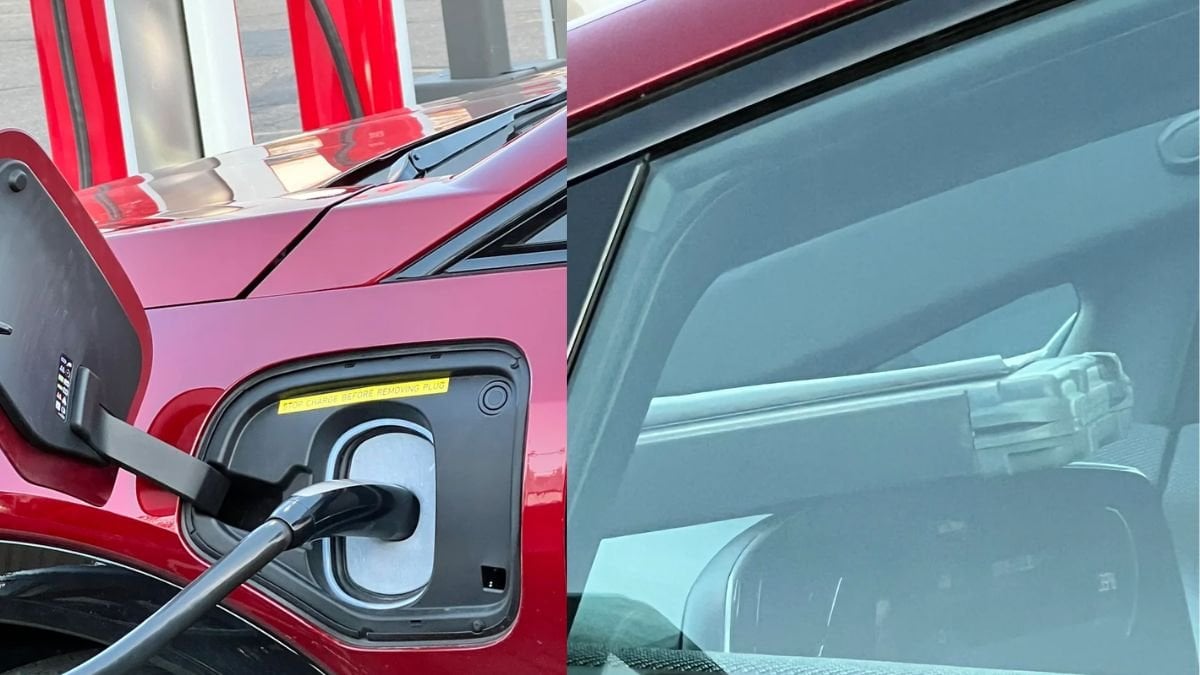
If the NACS charging experience can be demystified for people who remember rotary phones and carburetors, then it’ll likely work for everyone. It’s a case study in UX testing wrapped in a parking lot mystery.
U.S. New-Car Buyer Demographics At A Glance
- The average age of new car buyers in the U.S. is approximately 52 years old. This trend reflects the financial stability often required to afford new vehicles, as well as preferences for comfort and advanced features that appeal to this age group.
- Individuals aged 55 and older, who constitute about 30.5% of the U.S. population, account for nearly 48% of new car purchases. Their significant presence in the market underscores their purchasing power and influence on automotive trends.
- While the overall average age of new car buyers skews older, the electric vehicle (EV) segment attracts a younger demographic, with the average EV buyer being around 41 years old. This indicates a generational shift towards embracing new technologies and environmental considerations in vehicle choices.
And it’s not just about demographics, it’s about ergonomics. As Reddit user af_cheddarhead pointed out,
Advertising “The thicker cable and heavier CCS1 connector can make it difficult for those with less arm strength to manipulate to line up with the receiver.”
Especially in cold weather, when even young hands struggle with stiff plastics and clunky connectors.
In contrast, Tesla’s NACS plug is almost dainty by comparison, less “fire hose” and more “smartphone charger.” If you’re an automaker trying to make charging feel less like a chore, this is where you start.
Why Senior Testers Are GM’s Secret Weapon for EV Charging UX
What’s particularly fascinating is that this isn’t an isolated phenomenon. Multiple Redditors chimed in with eerily similar stories, elderly testers, mystery folders, and cars with test equipment or temporary plates. One said,
“They’re bored, happy to make some ‘beer money,’ and love driving interesting cars.”
It tracks. These aren’t just retired guys running errands, they’re the quiet foot soldiers in a nationwide usability test. You couldn’t plan this better if you tried. Who better to uncover real-world flaws than people who have absolutely no patience for bad design?
But the mystery folder remains. Both vehicles had one, sitting plain as day on the dash. Was it a testing checklist? A corporate NDA? The last known copy of a Saturn Ion owner’s manual? We may never know.
“Interestingly, the first vehicle did not have a manufacturer plate, but the second one did.”
The original poster noted. Which only deepens the intrigue. Is GM deploying a tiered approach to testing, some incognito, some flagged for internal tracking? Or is this just the inevitable chaos of a massive, legacy automaker trying to go digital overnight?
How Modern Cars Are Tested And Designed
- Modern automotive testing begins with advanced computer simulations, allowing engineers to model crash scenarios, aerodynamics, and system behaviors. These simulations enable rapid iterations and cost-effective design refinements. However, they are complemented by physical tests, such as crash tests and durability assessments, to validate simulation results and ensure real-world performance aligns with expectations.
- To guarantee vehicle reliability under diverse conditions, manufacturers subject prototypes to rigorous environmental tests. Facilities like Chrysler's climatic test cell can simulate temperatures ranging from -40°F to 130°F, as well as various precipitation and humidity levels. This ensures vehicles perform optimally, whether navigating icy roads or scorching deserts.
- Safety remains paramount in vehicle testing. Manufacturers conduct extensive crash tests, including frontal, side, and rear impacts, to evaluate occupant protection. For instance, in the UK, a dedicated facility performs head-on collision tests, often destroying multiple high-value vehicles to gather data. These tests inform design improvements, aiming to enhance safety features across all vehicle classes.
And GM’s slow roll into NACS territory with the Optiq hasn’t gone unnoticed by their most loyal fans. Over on Chevy forums, owners are already grumbling about delays in Supercharger access.
“I thought GM would be right behind Ford and Rivian.”
One Silverado EV owner complained. The optics haven’t been great, but scenes like this suggest there’s more going on than a simple software update. This isn’t just a compatibility issue; it’s a full-scale rethink of how GM’s customers interact with their vehicles. And if you want to know how well your system works, put it in the hands of people who are most likely to be confused by it. That’s how you design for clarity.
GM’s Low-Profile Strategy to Simplify EV Charging for All
So yes, while the rest of the industry chases OTA updates, metaverse dashboards, and AI-generated voice assistants, GM appears to be quietly refining the basic, physical act of plugging in your car.
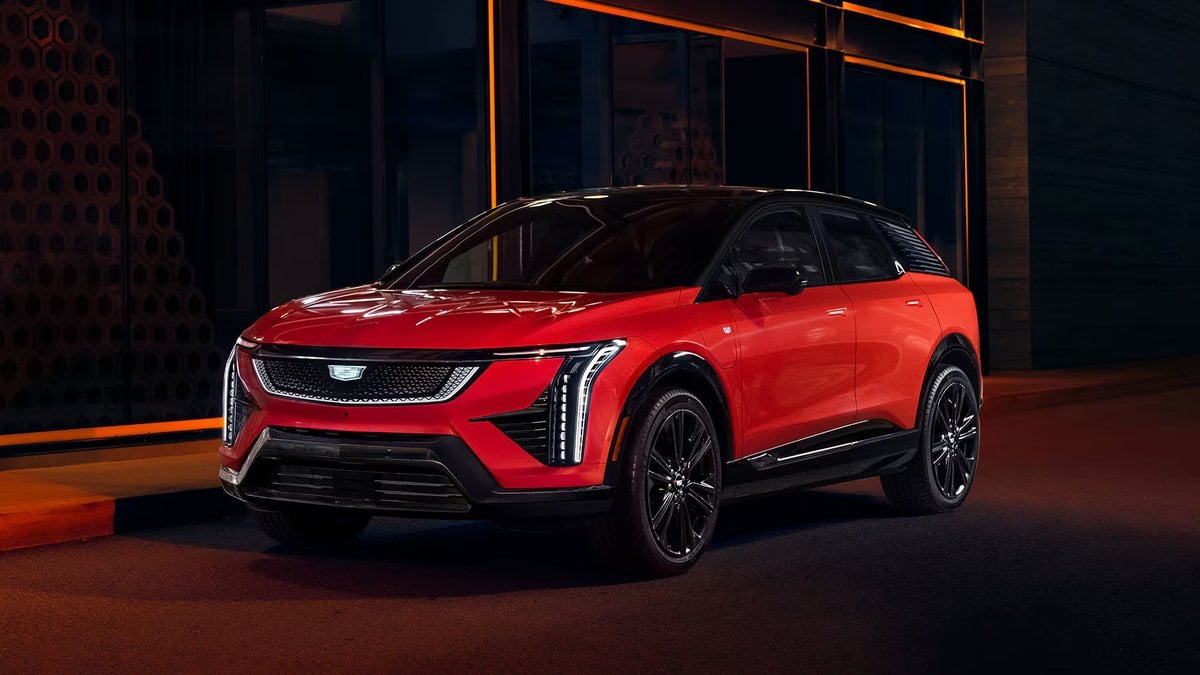
No splashy campaign. No flashy influencer partnerships. Just a couple of retired guys, quietly rewriting the UX manual at 5 mph and 500 rpm. It’s not glamorous, but it’s damned effective. And in a world that too often forgets that progress means accessibility, not just novelty, it might just be the most forward-thinking move Detroit’s made in years.
Image Sources: Cadillac Media Center
Noah Washington is an automotive journalist based in Atlanta, Georgia. He enjoys covering the latest news in the automotive industry and conducting reviews on the latest cars. He has been in the automotive industry since 15 years old and has been featured in prominent automotive news sites. You can reach him on X and LinkedIn for tips and to follow his automotive coverage.



